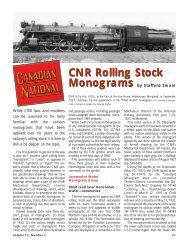CN LINES V12N3 - Canadian National Railways Historical Association
CN LINES V12N3 - Canadian National Railways Historical Association
CN LINES V12N3 - Canadian National Railways Historical Association
You also want an ePaper? Increase the reach of your titles
YUMPU automatically turns print PDFs into web optimized ePapers that Google loves.
occasion, if memory serves, of an RDC-4<br />
and an RDC-1. There were typically twoand<br />
three-car sets assigned to this run at this<br />
time. The view from the front of that<br />
RDC-4 will always stay with me. It was<br />
night, and in those days there was not the<br />
proliferation of farm lights you see now. It<br />
was pitch black and snowing. The image of<br />
the snowflakes seeming to form a funnel of<br />
white pinpoints of light, through which we<br />
raced with the two silver rails streaming<br />
back under our feet was an incredibly powerful<br />
experience. “<br />
Alberta and British Columbia<br />
(Runs 72 to 78)<br />
Edmonton and Calgary were the largest<br />
<strong>Canadian</strong> cities to receive Railiner service<br />
when the original Phase One units were<br />
delivered by 1955. <strong>CN</strong> RDCs operated<br />
out of Edmonton until the VIA takeover<br />
in 1978. The first route was south to<br />
Drumheller and Calgary in 1955 so as to<br />
provide some competition for the CPR.<br />
Service northward was added in the late<br />
1950s to St. Paul and Grand Centre. In<br />
November 1958, cars D-201, D-203 and<br />
D-401 were assigned to Calder and ran<br />
14,790, 10,161, and 9,400 miles, respectively,<br />
north out of Edmonton on Runs 72<br />
and 73.<br />
Of all the provinces in which they operated,<br />
<strong>CN</strong> Railiners were the least successful<br />
in British Columbia. We have been able to<br />
gain some understanding of the short-lived<br />
<strong>CN</strong> RDC service in B.C. from the files of<br />
the late Mr. C. C. Collins, former <strong>CN</strong><br />
Passenger Service Manager in Vancouver.<br />
The Railiners came to two B.C. runs in the<br />
early 1960s because of a plan to introduce<br />
RDCs on all secondary routes in the<br />
Mountain Region. However, Run 77 from<br />
Kelowna to Kamloops Jct. had seen falling<br />
patronage using conventional equipment<br />
on account of improved highways and the<br />
very inconvenient roundabout route to<br />
Vancouver via Kamloops. The two-year<br />
Railiner service mainly forestalled the loss<br />
of complete rail passenger service.<br />
On the B.C. North Line, the conventional<br />
trains were not being well utilized<br />
between Prince Rupert and Jasper. There<br />
was an overnight run and heavy head-end<br />
loads between Prince George and Jasper so<br />
this portion remained with a conventional<br />
train. The connecting service from Prince<br />
George to Prince Rupert was certainly<br />
more economical for <strong>CN</strong> to run with<br />
RDC cars, but they had considerable<br />
above: <strong>CN</strong> 6114 (ex-B&M) is waiting at Saskatoon for connecting passengers on July 28,<br />
1969. Note the black pilot, white letterboard, new headlight housing and frame for<br />
diaphragm (which has been removed to improve visibility for the engineer.)—Al Lill photo<br />
below: No. D-102 from Calgary and No. D-350 from Drumheller were at Edmonton in<br />
August 1959. The cars were coupled together Camrose–Edmonton.—F. D. Shaw photo<br />
bottom: <strong>CN</strong>R D-354 heads north out of Vernon, B.C., on July 30, 1963. It had been<br />
reassigned from Run 8 in New Brunswick and later went to Saskatchewan and Ontario before<br />
being rebuilt into an RDC-1m. Note the removable ditchlights used in B.C.—Roger Burrows photo<br />
Volume 12, Number 2 39



